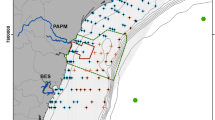Abstract
Several important mechanisms for storm-induced entrainment of estuarine cohesive sediments are analyzed using field measurements collected in a moderately energetic estuary, central Long Island Sound, U.S.A. The sediment concentration and hydrographic data were obtained by an array of sensors mounted at 1 m above the bottom. The bottom sediment in the study site composed mostly of silt and silty sand. The study showed that the bottom shear stress, computed using a wave-current interaction model, increased significantly during the episodic wind events. A large resuspension event was triggered by a frontal passage when strong wind-driven currents augmented the tidal currents. The timing of storm waves with respect to the tidal phase also was a critical factor. Based on the changes of suspended sediment concentration, the bottom appeared to respond to the shear stress in two phases: the tidal resuspension and the storm-induced erosion. During each tidal cycle, entrainment was associated with resuspension of high water content, loosely consolidated material. During episodic events, a thin layer of more consolidated bed below the sediment-water interface was eroded by the enhanced bottom stress.
Similar content being viewed by others
References
Allen, G. P., J. C. Salomon, P. Bassoullet, Y. Du Penhoat and C. De Grandpre (1979): Effects of tides on mixing and suspended sediment transport in macrotidal estuaries. Sed. Geol., 26, 69–90.
Bedford, K., O. Wai, C. Libicki and R. Van Evra, III (1987): Sediment entrainment and deposition measurements in Long Island Sound. ASCE, J. Hydr. Engr., 113, 1325–1342.
Blanton, J. O., J. A. Amft and D. A. Lee (1989): Wind stress and heat fluxes observed during winter and spring 1986. J. Geophys. Res., 94, 10686–10698.
Bohlen, W. F. (1982): In-situ monitoring of sediment resuspension in the vicinity of active dredge spoils disposal areas. IEEE Oceans '82 Proc., 1028–1033, New York, N.Y.
Bohlen, W. F. (1987): Time variability of suspended material concentrations in estuaries. Proc. 1987 Natl. Conf. Hydr. Engr., ASCE J. Hydr. Div., 219–224, Williamsburg, V.A.
Bokuniewicz, H. J. and R. B. Gordon (1980): Sediment transport and deposition in Long Island Sound. p. 69–106. In Advances in Geophysics 22, ed. by B. Saltzman, Academic Press, London.
Butman, B. (1987): Physical processes causing surficial-sediment movement. p. 147–162. In Georges Bank, ed. by R. H. Backus and D. W. Bourne, The MIT Press, Cambridge, Mass.
Cacchione, D. A. and D. Drake (1982): Measurements of storm-generated bottom stresses on the continental shelf. J. Geophys. Res., 87, 1952–1960.
Drake, D. E. and D. A. Cacchione (1986): Field observations of bed shear stress and sediment resuspension on continental shelves, Alaska and California. Cont. Shelf Res., 6, 415–429.
Gelfenbaum, G. (1983): Suspended-sediment response to semidiurnal and fortnightly tidal variations in a mesotidal estuary, Columbia River, U.S.A. Mar. Geol., 52, 39–57.
Govindaraju, R. S., S. R. Ramireddygari, P. L. Shrestha and L. C. Roig (1999): Continuum bed model for estuarine sediments based on nonlinear consolidation theory. J. Hydr. Engr., 125, 300–304.
Grant, W. D. and O. S. Madsen (1979): Combined wave and current interaction with a rough bottom. J. Geophys. Res., 84, 1797–1808.
Grant, W. D., A. J. Williams, 3rd and S. M. Glenn (1984): Bottom stress estimates and their prediction on the Northern California Continental Shelf during CODE-1: the importance of wave-current interactions. J. Phys. Oceanogr., 14, 506–527.
Kinsman, B. (1965): Wind Waves. Prentice-Hall, Englewood Cliffs, N.J., 676 pp.
Krone, R. B. (1962): Flume studies of transport of sediment in estuarial shoaling processes. Final Report, Hydr. Engr. and Sanitary Engr. Res. Lab., Univ. of California, Berkeley, C.A.
Lavelle, J. W., H. O. Mofjeld and E. T. Baker (1984): An insitu erosion rate for a fine-grained marine sediment. J. Geophys. Res., 89, 6543–6552.
Lesht, B. M., T. L. Clark, R. A. Young, D. J. P. Swift and G. L. Freeland (1980): An empirical relationship between the concentration of resuspended sediment and near-bottom wave-orbital velocity. Geophys. Res. Lett., 7, 1049–1052.
Lyne, V. D., B. Butman and W. D. Grant (1990): Sediment movement along the U.S. east continental shelf—I, Estimates of bottom stress using the Grant-Madsen model and near-bottom wave and current measurements. Cont. Shelf Res., 10, 397–428.
Mehta, A. J. (1989): On estuarine cohesive sediment suspension behavior. J. Geophys. Res., 94, 14303–14314.
Parmeshwar, L., P. L. Shrestha and G. T. Orlob (1996): Multiphase distribution of cohesive sediments and heavy metals in estuarine systems. J. Env. Engr., 122(8), 730–740.
SAIC (1984): Results of monitoring studies at cap site #1, #2, and the FVP site in central Long Island Sound and a classification scheme for the management of capping procedures. DAMOS Contribution #38, SAIC, Newport, R.I.
SAIC (1990): Disposal area monitoring system progress report. DAMOS Contribution #68, SAIC, Newport, R.I.
U.S. Army Corps of Engr. (1984): Shore Protection Manual. U.S. Army Engr. Waterways Exp. Stn., Vicksburg, Mississippi, Government Printing Office, Washington, D.C.
Wakeland, M. E., Jr. (1979): Provenance and dispersal patterns of fine-grained sediments in Long Island Sound. Ph.D. Dissertation, Univ. of Connecticut, Storrs, C.T.
Walters, J. T. and C. Heston (1982): Removing tidal-period variations from time-series data using low-pass digital filters. J. Phys. Oceanogr., 12, 112–115.
Ward, L. G. (1985): The influence of wind waves and tidal current on sediment resuspension in middle Chesapeake Bay. Geo-Marine Letters, 5, 71–75.
Author information
Authors and Affiliations
Rights and permissions
About this article
Cite this article
Wang, Y., Bohlen, W.F. & O'Donnell, J. Storm Enhanced Bottom Shear Stress and Associated Sediment Entrainment in a Moderate Energetic Estuary. Journal of Oceanography 56, 311–317 (2000). https://doi.org/10.1023/A:1011155717622
Issue Date:
DOI: https://doi.org/10.1023/A:1011155717622



